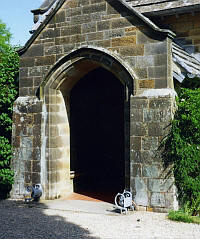|
|
|
|
 Welcome! Please come in and look round! ê |
The memorial windows on the south
wall (to the right in the picture) were made by J. C. N. Bewsey, whose mark is shown in the bottom right corner of the panel
nearest to the church door. The two windows depict saints associated
with the church and local area. Starting at the panel nearest the door
you can see: St Cuthbert, St Hilda, St Aidan, St Nicholas, The Virgin
Mary and St Boniface. The Chancel arches One of the most striking features of the interior design of the church is the twin arches which support the tower. The clock and bells are in a chamber above them. This chamber may be visited by arrangement. The Pulpit The pulpit is more than four hundred years old (likely date 1603). It stood in two earlier churches on this same site. The bells
The clock
The clock by
William Potts and Sons of Leeds was installed in 1901 at the same time
as the ring of five bells. It tells the time on two dials, one on the
east face of the tower and one on the north. It has been extensively
modified over the years to use up-to-date power sources and
regulating technology. The organ The organ is situated to the right between the chancel arches. It was built and installed in 1899 by Messrs Harrison and Harrison of Durham who have maintained it ever since. Its details can be found here: http://www.npor.org.uk/cgi-bin/Rsearch.cgi?Fn=Rsearch&rec_index=N02982 A Mr Barnard of St Hilda's church in Whitby had advised the Vicar, Revd Ernest Hare: "I like my little organ at St Hilda's so well that I wish you would do something on the same lines for Goathland." In fact St Hilda's had cost £210 and St Mary's could afford only £120, but a deal was done for a scaled down version. You can read the Vicar's original letter ordering the organ here. The old altar table
The East Window The stained glass east window, showing the life of Jesus is described on a separate page. |
|
The Font
The font cover (not shown) is much more recent. It was a gift at the baptism of a little boy in July 1903. He had been born the previous winter when his parents, whose home was in York, had become snowed in at the Mallyan Spout Hotel. The cover expresses their gratitude and is marked with his name. The George III coat of arms
The Millenium Windows The stained glass windows in the west wall were commissioned for the Millennium. They are described on a separate page. The Mice!
|
| © Goathland PCC 2012 |